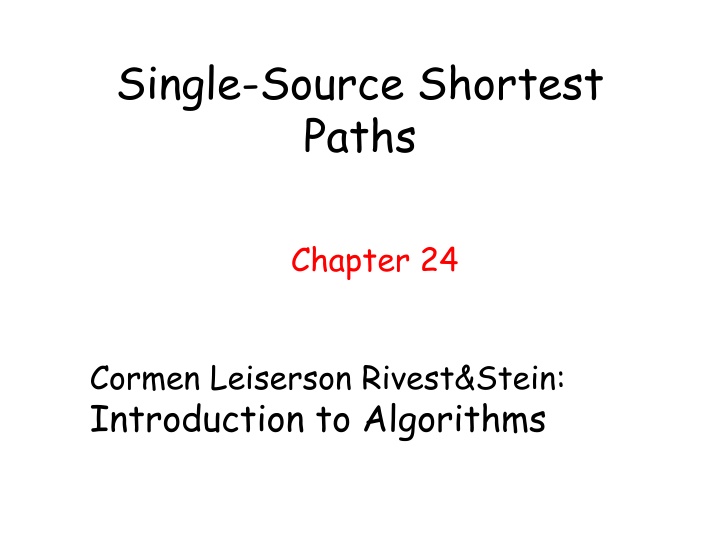
Shortest Paths in Weighted Graphs: Applications and Algorithms
Discover the concepts of single-source shortest paths in weighted graphs, including their applications in geographical maps, satellite navigators, and internet routing. Learn about Dijkstra's algorithm, relaxation, and representing shortest paths efficiently.
Download Presentation

Please find below an Image/Link to download the presentation.
The content on the website is provided AS IS for your information and personal use only. It may not be sold, licensed, or shared on other websites without obtaining consent from the author. If you encounter any issues during the download, it is possible that the publisher has removed the file from their server.
You are allowed to download the files provided on this website for personal or commercial use, subject to the condition that they are used lawfully. All files are the property of their respective owners.
The content on the website is provided AS IS for your information and personal use only. It may not be sold, licensed, or shared on other websites without obtaining consent from the author.
E N D
Presentation Transcript
Single-Source Shortest Paths Chapter 24 Cormen Leiserson Rivest&Stein: Introduction to Algorithms
Shortest path Weighted Graphs G(V, E, w) W: E R If w=1 for all edges BFS is the solution. Weight w(p) of a path p = {v0, v1, , vk) is the sum of weights of its edges: w(p) = i=1,k w(vi-1,vi) Shortest-Path distance is the shortest path with minimum w(p).
MST and Shortest path tree MST Starting from a minimizes the global sum of weights of the edges SPT Minimized the distances (sum of weights) from a to all the other nodes
Single-Source Shortest Paths 2 very important applications : Geographical maps and satellite navigators. Internet : Routing of messages
Representing Shortest Paths Not only compute the value of min w(p) but also the path associated to this weight. Use predecessor as in BSF u, (u) and the procedure PrintPath. First build the Shortest path tree For the Routing Problem: Compute the shortest path from any source. Routing tables: for each destination specifies the next hop in the shortest path.
Relaxation Typical operation of the computation of the SPT. Update the value v.d of the SPT computed so far to a better value. v.d > u.d +2 RELAX ! v.d < u.d +2 DO NOT RELAX ! UPDATE: v.d = u.d +2 NO UPDATE
Dijkstras algorithm 1. Assign to every node a tentative distance value: set it to zero for our initial node and to infinity for all other nodes. 2. Set the initial node as current. Mark all other nodes unvisited. Create a set of all the unvisited nodes called the unvisited set. 3. For the current node, consider all of its unvisited neighbors and calculate their tentative distances. Compare the newly calculated tentative distance to the current assigned value and assign the smaller one. ( Check Relaxation)
Dijkstras algorithm 4. When we are done considering all of the neighbors of the current node, mark the current node as visited and remove it from the unvisited set. A visited node will never be checked again. 5. If the destination node has been marked visited or if the smallest tentative distance among the nodes in the unvisited set is infinity then stop. The algorithm has finished. 6 Otherwise, select the unvisited node that is marked with the smallest tentative distance, set it as the new "current node", and go back to step 3.
Dijkstras algorithm correctness Invariant: For each visited node v, v.d is the shortest distance from source to v. For each unvisited node u, u.d is the shortest distance via visited nodes only, from source to u (if such a path exists, otherwise infinity); Proof by induction
Correctness sketch After processing u it will still be true that for each unvisited node w, w.d is the shortest distance from source to w using visited nodes only, since: if there were a shorter path which doesn t visit u we would have found it previously; if there is a shorter path using u we update it when processing u .
Dijkstras algorithm analysis Instructions 1-3: O(V) Instructions 4-8: O((V+E) log(V)) if Q is implemented with a heap. Total: : O((V+E) log(V)) Operation DECREASE KEY in a heap can be performed in O(logV) time.
Semi external algorithm for MST-Kruskal Semi external: the cache is big enough to contain the Union Find data structure but not Graph. Sort the edges using any optimal external (2-level model) sorting algorithm. Scan the edges in order of increasing weight, as for the normal algorithm. If an edge is selected for the MST, output it. Number of I/O s operations as Sorting.
External algorithm for MST - Kruskal Try to reduce the number of nodes! Edge contraction: Reduce the vertices from n to n . For v=1 to n-n find the lightest edge (u, v) incident to v and contract it When after contraction n becomes n adopt semi- external algorithm.
Contraction Edge (c, a, 6) is the cheapest incident in a. Contract it: merge a and c to c. Relink a: (a, b, 7) becomes (c,b, 7), (a,d,9) becomes (c, d, 9). Output (b,d,2)
Contraction Contraction can be implemented using a priority queue both to find the cheapest edge incident to v and to relink the other edges incident to v. For each edge e=(u,v) we have to store the additional information: Edges are sorted according to weight and according to the lower endpoint. Contraction is proportional to sum of the degrees of the nodes encountered. Complexity: worst case O(n2) I/O s n=|V|, m=|E| Expected : O(sort(m)log n/n ) I/O s {min(u,v), max(u,v), w(e), original e}
